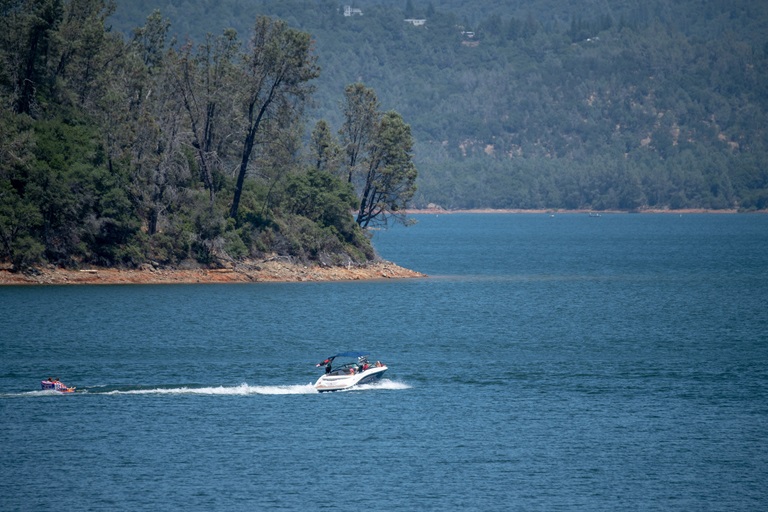Lake Oroville Community Update - February 12, 2021
Boater on Lake Oroville. DWR/2019
Oroville Dam Citizens Advisory Commission Public Meeting
The California Natural Resources Agency is hosting its sixth Oroville Dam Citizens Advisory Commission meeting on Feb. 19 from 9 a.m. to 11 a.m. The public meeting will be held online and will include presentations and public comment. The Commission will receive an update on fire modernization at the Hyatt Power Plant, winter operations, and a presentation from the Yuba Water Agency on downstream flood management. The Citizens Advisory Commission is a forum for the community to provide feedback and ask questions. For information on how to join the virtual meeting, please visit https://bit.ly/OrovilleCAC
Thermalito Powerplant Update
The Thermalito Powerplant (THPP), formally named the Ronald B. Robie Thermalito Pumping-Generating Powerplant, has returned to full service after losing operational capacity when it was damaged by fire in November 2012. The powerplant has been re-constructed with modern fire and life safety features, and the plant’s electrical protection, control, and communications systems have been fully replaced. The thousands of connections in the plant’s new systems underwent the strict and rigorous ‘interconnection’ requirements of Pacific Gas & Electric (PG&E) to safely re-connect the powerplant to the state’s electrical grid.
The THPP is one of three hydroelectric powerplants in the Oroville-Thermalito Complex, capable of generating 118 megawatts – enough to power roughly 100,000 households and adding value to the approximately 714 megawatts produced by Oroville Dam’s Edward Hyatt Powerplant. Along with the Thermalito Diversion Dam Powerplant, the Oroville-Thermalito Complex is California’s State Water Project’s leading producer of clean hydro-electric power.
Wildfire Impacts on Water Quality
The multi-agency “Watershed Working Group”, led by the California Governor’s Office of Emergency Services (CalOES), continues targeted monitoring of rivers, lakes, and other surface waters in the North Complex burn area and downstream. The Central Valley Regional Water Quality Control Board (Water Board), the California Department of Fish and Wildlife (CDFW), and the Department of Water Resources (DWR) collect and test water samples for analysis. The Water Board’s recent news release states elevated results found are not impacting drinking water treatment facilities nor the quality of drinking water. Butte County held a Facebook Live event on Feb. 10 to provide information about the Watershed Working Group’s efforts to protect water quality.
Water testing will continue and the Watershed Working Group will report results in the weeks ahead. The Water Board will alert the public if results show water quality may be impacted.
Oroville Recreation
The California Department of Parks and Recreation (CA Parks), in compliance with the modification for the Greater Sacramento Region’s COVID-19 public safety restrictions, opened Lake Oroville State Recreation Area (LOSRA) campgrounds at Bidwell Canyon, Loafer Creek, including the Equestrian Campground, and the Lime Saddle Campground. En route camping at the North Forebay and Spillway facilities is permitted. Group camping remains closed. Reservation capability does not open until April and camping sites will be allocated on a ‘first come-first serve’ basis.
The Potters Ravine and North Fork trails are open for use. CA Parks encourages users to remain on the trails. Assessments by CA Parks staff of trail safety will continue through the winter. All day use facilities at Lake Oroville State Recreation Area (LOSRA) are open. The Lake Oroville Visitors Center remains closed.
Visit the California Parks LOSRA webpage for current information on facility status as well as current requirements to protect public health during the COVID-19 pandemic. Information about recreation facilities can be found in DWR’s interactive map on the Lake Oroville Recreation webpage. For information about the Oroville Wildlife Area, including the Thermalito Afterbay, visit the California Department of Fish and Wildlife webpage.
Lake Oroville Boat Ramps
The Bidwell Canyon and Spillway boat ramps are open for use. Bidwell Canyon is open 24-hours per day and the Spillway boat ramps are open from 6 a.m. to 8 p.m. daily. The Lime Saddle and Loafer Creek boat ramps are currently still out of the water.
The Loafer Point Stage II boat ramp project continues to construct six boat launch lanes and 180 trailered parking spaces to allow boaters to enter the lake when lake levels are below 805 feet elevation. This year’s low lake levels provided DWR the opportunity to build the ramp down to elevation 703 feet. When the lake levels are lower due to dry years in the future, the ramp will be extended to lower lake elevations.
The Loafer Point Stage I boat ramp was completed in 2020 and added three new boat launch lanes from a full lake down to 799 feet, a new parking area, and new restroom facilities. Both facilities are adjacent to the Loafer Creek Recreation Day Use Area and Campground, rounding out a full-service recreation destination with nearby trails, campgrounds, boating and marina.
Current Lake Operations
The elevation of Oroville’s reservoir is about 702.5 feet elevation and storage is about 1.27 million acre-feet, 54 percent of historical average. Currently, in the Northern Sierra Basin, rainfall is below average, at 53 percent of normal for this time of year and snowpack is also below average at 66 percent of normal. Chance of rain is forecasted for Saturday, with a slight chance of additional rainfall and cooler temperatures early in the week of Feb. 15.
The total releases to the Feather River continues to be at 1,250 cfs to conserve storage in Lake Oroville. The Feather River flows consist of 800 cfs down the Low Flow Channel through the City of Oroville, and 450 cfs from the Thermalito Afterbay Outlet (Outlet) for a total of 1,250 cfs for the Feather River’s high flow channel downstream of the Outlet.
The public can track precipitation, snow, reservoir levels, and more at the California Data Exchange Center at www.cdec.water.ca.gov. Lake Oroville is identified as “ORO”.
All data as of midnight 2/11/2021
